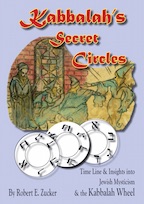|
Kabbalah Home
"Kabbalah's Secret Circles"
Jewish Mysticism &
the 231 Holy Gates
 "Kabbalah's Secret Circles," is a comprehensive book by author Robert E. Zucker
that examines the practices, literature, legends and history of Jewish
mysticism, Kabbalah, the "Sefer Raziel" and the "Sefer Yetzirah" (Book of Creation).
Instructions how to construct a Kabbalah Wheel to decipher the mystical
231 Holy Gates are provided. "Kabbalah's Secret Circles," is a comprehensive book by author Robert E. Zucker
that examines the practices, literature, legends and history of Jewish
mysticism, Kabbalah, the "Sefer Raziel" and the "Sefer Yetzirah" (Book of Creation).
Instructions how to construct a Kabbalah Wheel to decipher the mystical
231 Holy Gates are provided.
This book is a compilation of
ancient instructions, lost and forgotten legends, and insights to the
practice of Kabbalah with over 700 footnotes of sources to original
materials. Virtually all major Jewish and Christian Kabbalah practices are
covered.
The first few
chapters of the "Sefer Yetzirah" (also called the Book of Creation or
the Book of Formation) are closely examined word by word to provide the
steps to construct an ancient Kabbalah Wheel.
In "Kabbalah's
Secret Circles" discover the many lost and forgotten secrets of the
Kabbalah through the words of famous Rabbi’s and authors throughout
history.
Follow a historical
time line of Judaic mysticism across thousands of years and understand
some of the basic principles of the Kabbalah (Cabalah)
through history and legends.
Author Robert Zucker also published a book on Astral Projection and dream awareness. Read sample chapters and download a free sample PDF of the book "Twilight of Consciousness."
 Read Selections from "Kabbalah's Secret Circles" Read Selections from "Kabbalah's Secret Circles"
Ancient Kabbalah Manuscripts
Kabbalah Mysteries
Famous Kabbalists
The Kabbalah Wheel Instructions to create your own magical device.
Download Free PDF Sample "Kabbalah's Secret Circles"
- Download Free PDF sample of "Kabbalah's Secret Circles" Preview (link opens new window)
Purchase a Copy in Print or Digital of "Kabbalah's Secret Circles"
Purchase "Kabbalah's Secret Circles" in Tucson Arizona bookstores:
Also Available in bookstores online Internationally
Learn more about the Kabbalah through my website

Art work, "Spirits" (1976) by Robert Zucker. ©
What is the Kabbalah?
Jewish
mysticism bridges the connection between the material and the mystical
worlds in order to become spiritually closer to God.
For
centuries, only a few learned rabbis and their followers practiced these
mystical traditions and kept them hidden from the general public.
This collective knowledge, or tradition, became known as the Kabbalah.
The word ‘Kabbalah’ (Q-B-L-H) comes from the
Hebrew word that means “reception” or “tradition” The Kabbalah is the
Oral Tradition, or Oral Law, received by the ancient Jewish people.
The
medieval term “cabal” described a circle of people who shared similar
interests at the exclusion of outsiders– similar to a secret society.
This secretive
knowledge was passed by word of mouth between those privileged few for
thousands of years until it was first written down about 2,000 years
ago. The advent of the printing press made it possible for the masses to
eventually have access to these cryptic documents.
There is no one
authoritative book on the Kabbalah. Since these teachings were
originally transmitted verbally there were numerous interpretations.
Each group put its own spin on the original concepts.
But, there is an underlying theme common among all of them embodied in the concept of the Tree of Life.
The ancient manuscripts of the SEFER YETZIRAH, the BAHIR, the ZOHAR and SEFER RAZIEL are some of the most popular handbooks on Kabbalah that still exist today.
These works, including the TORAH, provide the cornerstones to understand this secretive, mystical practice.
Some practitioners only focused on the religious aspects of the Tree of Life and its ten spheres.
Other groups
practiced with mystic meditations, letter permutations, magical
techniques and chants. Either way, they depended on the basic principles
of the Kabbalah to achieve their goals.
While the true
knowledge is buried deep in the Hebrew language, Christian Kabbalists
of the Middle Ages introduced these concepts into the Western world.
Jewish Kabbalists followed to the original traditions, Christian
Cabalists interpreted the Semitic teachings through the veil of their
own religious views.
But, Kabbalah
is not a religion. The Kabbalah is based on virtual ideas, images and
relationships. It is a meditative look into one’s soul and into the
reflection of a greater energy.
Understanding
the deeper, symbolic meaning of each of the 22 Hebrew letters is key.
Rather than rehash the fundamental principles of the
Kabbalah, from the many books mentioned in this volume, this book
explores the development of Jewish mysticism and the Kabbalah through a
historical time line.
A full road map
of authors, Jewish authorities and various published editions of the
SEFER YETZIRAH from ancient times to present day are included in this
survey.
While the
Kabbalah is complex to understand for many lay people, there are basic
principles that everyone can understand. They are revealed in the words
of the some of the most famous rabbis in the Jewish religion.
At the end of
this volume is the text from SEFER YETZIRAH– the book that greatly
influenced Jewish thought over the centuries. Instructions to assemble a
simple, but ancient device, Kabbalah Wheel, to encode the multitude of combination of the Hebrew alphabet, are also published at the end.
Also included are copies of the original, personal notes from my studies used over the decades to map this path across time.
The Basics about Kabbalah
Purchase Kabalah items: bracelet, posters, books, DVDs, CDs from Amazon.com.
Additional Kabbalah Manuscripts by Robert Zucker
 "Twilight of Consciousness" "Twilight of Consciousness"
"Hermetics"
"Living Inside Your Dreams"
Robert E. Zucker
is an author, publisher and former college instructor in journalism.
He has studied and taught courses on Kabbalah since the late 1970s.
© 2018-2023 Copyright by Robert Zucker. Entertainment Magazine. EMOL.org. No part may be copied, reproduced, republished or digitally stored without permission from author.
|